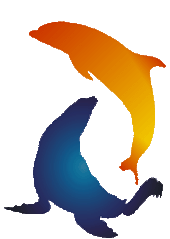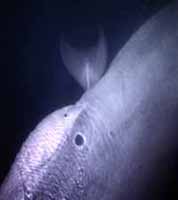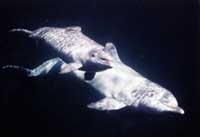Introduction
Animals
Training
Fleet Systems
Mine Hunting
Force Protection
Object Recovery
Fleet Support
Deployments
Marine Mammal Health Care
Research Programs
NMMP FAQs
Calendar Wallpaper
Internship Program
In The News
Organizational Chart
Annotated Bibliography

From the beginning of the NMMP, scientific research has been conducted to support the development of systems and technology and to gain a better understanding of the animals. The more we know about marine mammals, the better we can protect them. As a result, the NMMP is the single largest contributor to the literature on marine mammals (over 800 technical publications). This research, conducted by both staff and visiting scientists, has covered a broad spectrum of topics including hydrodynamics, sensory systems, anatomy and physiology, health care, behavior, reproduction, telemetry, open sea operations, and environmental ecology. This work is facilitated by well-trained animals that can participate in research in ocean pens, pools, or open water.
 Research on the immune systems of marine mammals will continue to help the Navy provide them with the finest health care possible. |
All of the animal research at the NMMP has always been conducted under the oversight of an Institutional Animal Care and Use Committee (IACUC) that reviews all proposals for scientific value and validity, and to ensure safe keeping of the study animals. Our research is currently focused on several major areas with the continuing goal of safeguarding our forces at sea, responsibly protecting the marine environment, providing our animals with the best health care possible, and understanding marine mammal bioacoustics. Following are samples of some of the work underway.
Animal Health:
To ensure the ongoing health and overall longevity of our animals, a major effort is made to explore and improve marine mammal medicine and care. Today veterinary techniques take advantage of animals cooperatively participating in routine medical examinations that involve the drawing of blood and the use of endoscopy and ultrasound scans to monitor the condition of each animal. Research on marine mammal immune systems, the development of DNA-based vaccines, and the assessment of risks that may be posed by various infectious diseases are critical to the health and operability of the animals. Research into and the development of techniques for artificial insemination are underway which may provide genetic diversity to bottlenose dolphin breeding programs around the world. Combining the extensive animal health database maintained by the NMMP and the frequent deployment of animals around the world, NMMP scientists are also investigating the possibility of our dolphins acting as environmental sentinels to monitor the condition of the world's oceans.
Bioacoustics:
Dolphins have highly sophisticated, natural sonar (biosonar) that allows them to detect objects in the most complex of acoustic environments. By emitting broadband high frequency clicks and listening to the echoes of the clicks as they bounce off objects, dolphins can acoustically "see" their aquatic environment in amazing detail. The dolphin's biosonar system has yet to be matched by any manufactured device. After decades of conducting research into the dolphin's biosonar capabilities (research that has literally defined what we do know about dolphin biosonar), the NMMP's Biosonar Program has constructed the world's first biomimetic (think bio mimic) sonar to try to emulate dolphin sonar and incorporate search strategies that are specifically effective in the noisy near shore environment.
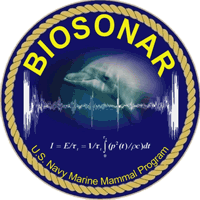
|
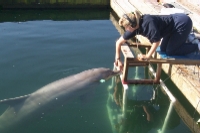 A dolphin participating in research |
The Biosonar Program has two main efforts: 1) the development of a biosonar measurement tool (BMT) and 2) the design, fabrication and testing of a prototype dolphin-based sonar (DBS) as a test platform to evaluate various biomimetic signal-processing strategies gleaned from the BMT. The Office of Naval Research funded the BMT effort and The Defense Advanced Research Projects Agency (DARPA) funded the DBS. The BMT is a dolphin-wearable computer that collects the emitted clicks of the animal and all the returning echoes during a free open-ocean target search and detection task. The BMT has an on-board 9-degree of freedom inertial navigation system that collects the animal's position and movement in three dimensions and is earth-referenced using a differential GPS. The enormous amounts of data collected by this device are reconstructed in a virtual environment in order for researchers to explore and focus on a section of the animal's total behavior and signals that can guide development of underlying principals of the animal's search and detection strategies.
 The Biosonar Measurement Tool (BMT) |
 A dolphin is given the BMT to record his search |
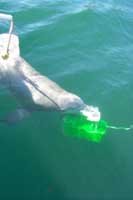 The dolphin on its way with the BMT. |
The second effort was completed in cooperation with Applied Research Laboratory, University of Texas at Austin (ARL). ARL and SSC San Diego designed and built the wet-end of the DBS. SSC San Diego has built the dry-end: the topside control and signal processing unit and the instrument shelter required to take the system to sea for testing in the shallow water. The DBS incorporates current knowledge of dolphin-based biosonar signal generation, echo detection, environmental adaptive search strategies, and target classification principles (learned from the BMT data analysis) non-developmental hardware sonar system, and compared its performance to dolphin performance in similar target detection and classification tasks. The new prototype sonar incorporates both physical and acoustical parameters of the dolphin's biosonar system and has proved extremely effective in initial testing. Further development will explore increasing accuracy, reducing size, and incorporation into mechanical platforms. The program goal is to eventually provide the Fleet with hardware sonar systems that can perform as well as the dolphin in the shallow water or very shallow water environment.
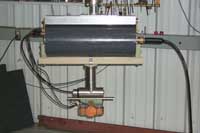 The "wet end" of the Dolphin Based Sonar (DBS) system. The electronics are in the gray pressure vessel, and the transducer array is below on a pan and tilt mechanism. |
 The DBS transducer array is what mimics the dolphin's natural sonar. |
 Some of the DBS electronics |
Hearing:
The potential effects of anthropogenic (human-generated) sound on marine mammals have gained the attention of lawmakers, the military, and conservation groups. How much noise is too much? The NMMP's scientists and animals are helping to answer that question by defining acoustic safety criteria: first, to ensure the safety of Navy animals and second, to provide scientific data that can be applied to marine mammals in the wild. Belugas participated in open water tests to determine how sensitive their hearing was at various depths. The results showed that their hearing ability was the same at all depths. Dolphins trained for hearing tests are involved in investigating temporary threshold shift (TTS), a condition during which one's hearing sensitivity is temporarily reduced as a result of exposure to loud noise (the experience audiences have after a loud rock concert). By testing the dolphins and belugas under safe parameters, experimental results combined with data from other investigators can serve to predict the level of sound that is safe for marine mammals in the wild.
 The Navy is investigating the effects of noise on marine mammals |
Environmental Compliance Support:
The oceans of the world are home to marine mammals as well as other forms of marine life. The Navy needs to operate freely in that environment to ensure National security. At the same time, the Navy respects the need to preserve and protect the environment. New systems and various forms of Naval activities must follow environmental regulations just like everyone else. Scientists in the NMMP are the Navy's marine mammal experts. That is why we, more so than ever before, are active in and frequently called upon to provide technical support for environmental compliance and guidelines for Naval operations where wild marine mammals may be present. Here, our scientists, trainers, and engineers make a major contribution toward protecting life in the world's oceans.
Dolphin Breeding Program:
An aging Fleet animal must be replaced with an animal that is trained and ready to step in and fill the position. To provide young dolphins for future service to the Fleet, we have developed the Dolphin Breeding Program, which extends from breeding and birth through the initial training for calves. The objectives of the program are to promote successful calf production and to develop young dolphins so that they are ready for more advanced, follow-on training. Because of the success of this program, no dolphins have been collected from the wild since 1988; all new animals have been born at the facility.
Calves are typically energetic and curious, and training sessions are designed to take advantage of this. Early training includes teaching calves how to follow small boats and how to slide out of the water onto beaching trays. It also includes getting the calves accustomed to various things such as boat motors, people in wetsuits, and divers in the water. This is facilitated by the fact that calves tend to mimic adults, especially their mothers. As training progresses, each calf is taught other essentials of the Marine Mammal Systems such as wearing special equipment, leaving the familiar enclosure area to swim for short periods of time in the open water before returning to the enclosure, and beaching into a specially designed boat and going for a ride. They are also provided a chance to socialize with a variety of other dolphins that are in the program, some of which may be their own age and energy level. At the end of a long day, the mothers often take time out for a nap while the calves play together in a game of tag and chase.
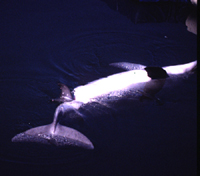 A dolphin giving birth. |
